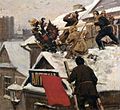Ivan Vladimirov
- Machine translation, like DeepL or Google Translate, is a useful starting point for translations, but translators must revise errors as necessary and confirm that the translation is accurate, rather than simply copy-pasting machine-translated text into the English Wikipedia.
- Do not translate text that appears unreliable or low-quality. If possible, verify the text with references provided in the foreign-language article.
- You must provide copyright attribution in the edit summary accompanying your translation by providing an interlanguage link to the source of your translation. A model attribution edit summary is
Content in this edit is translated from the existing Russian Wikipedia article at [[:ru:Владимиров, Иван Алексеевич]]; see its history for attribution. - You may also add the template
{{Translated|ru|Владимиров, Иван Алексеевич}}to the talk page. - For more guidance, see Wikipedia:Translation.

Ivan Vladimirov, also John Wladimiroff (Russian: Владимиров, Иван Алексеевич) (10 January 1870 [O.S. 29 December 1869] – 14 December 1947) was a Russian artist: painter and graphic artist. During the wars of 1904–1916, he became known as a war artist ("batalist").[1][2] Afterwards, his image has become controversial. In the Soviet Union, he was known for paintings that glorified the October Revolution.[2] However, in the West and in Russia after the dissolution of the Soviet Union, he has become known for harshly critical imagery of the aftermath of the Revolution.[3][4][1][5][6][7]
The two sides of the Revolution
-
 "Down with the Eagle" (tearing down symbols of the Russian Empire), 1917
"Down with the Eagle" (tearing down symbols of the Russian Empire), 1917 -
 "On the Streets of Petrograd", 1918
"On the Streets of Petrograd", 1918 -
 "Prodrazvyorstka" (grain requisitioning)
"Prodrazvyorstka" (grain requisitioning) -
 "Clergy on forced labour", 1919
"Clergy on forced labour", 1919
Biography
Ivan Vladimirov was born in Vilnius to Russian intellectual Aleksei Porfirievich Vladimirov, a priest,[7] and a British mother, Catherine Waghorn, a watercolor artist. In non-Russian documents, the family spelled their name as Wladimiroff and the artist spelled his name in English as John Wladimiroff.[3]
He is interred in the Serafimovskoe Cemetery, St. Petersburg.[7]
Awards and decorations
- 1946: Honored Artist of the RSFSR[7][2]
- 1945: Order of the Red Banner of Labour, for the "fruitful activity in the field of Soviet art"[7][2]
- Various medals[2]
- 1897: "Class artist [ru] of the first degree" title for the painting "Бой адыгейцев на реке Малке" ("The Battle of Circassians by Malka River") [6]
- 1890s: Awards for battle scenes[1]
References
- ^ a b c Peter Harrington, "Views of War and Revolution in Russia"
- ^ a b c d e "Владимиров Иван Алексеевич", in: Great Soviet Encyclopedia
- ^ a b "The Double Vision of Battle Artist Ivan A. Vladimirov", Russian print version: Окаянные годы : революция в Россииглазами художника Ивана Владимирова, London : Ruzhnikov Publishing, Vicenza, Italy : Artveneto 2019
- ^ Свидетель истории. Художник Иван Владимиров
- ^ Natalya Batorevich, Всю жизнь я служил России... Жизнь и творчество И. А. Владимирова, Sankt-Petersburg, 2013, ISBN 978-5-86007-724-9, a detailed biography by Vladimirov's granddaughter
- ^ a b Anatoli Roshchin, Иван Алексеевич Владимиров. Жизнь и творчество. 1869 – 1947., Leningrad, 1970
- ^ a b c d e Иван Владимиров
- v
- t
- e













